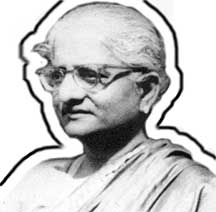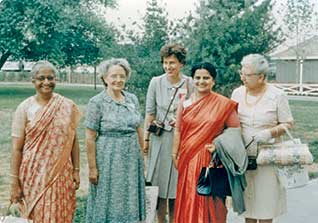Mamata Pandya
Today there are hundreds of engineering colleges in India and tens of thousands of students, both boys and girls, who compete to gain places in the best of these. While the idea of a woman pursuing engineering is not uncommon today, the way had been paved by spunky pioneers who took on numerous challenges in a different time and circumstances. One of these pioneers was A. Lalitha.

Courtesy: Syamala Chenulu
Lalitha was born on 27 August 1919 in a middle-class Telugu family, one of seven siblings. Her father was an engineer and a fairly broad-minded person. However societal norms and expectations took precedence over his personal beliefs. Thus, as was the norm in those days, while Lalitha’s brothers were supported in pursuing higher studies, the girls in the family were educated only till the primary level, and then married off. Lalitha herself was married at the age of 15. But her father ensured that even in her new life she could continue to study till she completed class 10.
Sadly Lalitha’s married life was short-lived. Her husband passed away when she was just 18 years old. She suddenly became a young widow with a four-month-old daughter, living in a society where widows were shunned and relegated to a life of isolation and austerity. This is where Lalitha’s fighting spirit led her to quietly start breaking the first of many barriers.
She moved back to her father’s house with a strong resolve to study and get a professional degree so that she could become self-reliant in the future. Her father supported her decision, and Lalitha cleared the intermediate exam from Queen Mary’s College in Madras. This was the first step to moving ahead.
At the time there were women who were studying medicine. But Lalitha felt that a career in medicine would not leave her sufficient time and attention for her young daughter, who was her priority. Living in a family of engineers, this was an option that came to her mind. At that time technical education was itself in a nascent stage in India, and the idea of women entering this field was unheard of. No institute was admitting women. Once again, her father Pappu Subbarao helped to open a door for his daughter. He was a professor of electrical engineering in the College of Engineering (CEG) in Guindy, and he put up a special request to the then principal of CEG Dr KC Chacko, that his daughter be permitted to take up an engineering course. He also put forward the appeal to the Director of Public Instruction, RM Statham. Luckily, both these officials were forward thinking and were agreeable to opening admission for a woman for the first time in the history of CEG. Lalitha applied for the electrical engineering course.
Thus Lalitha became the only girl in a college with hundreds of boys. But as accounts go, she never felt uncomfortable there. Accommodation in a separate hostel was arranged for her, while her daughter was looked after by her brother’s family; Lalitha visited her every weekend. While Lalitha was comfortable and happy in her classes, she missed having company in the hostel. Once again her father encouraged the authorities to open admissions for more women. In response to the advertisement two more women – Leelamma George and PK Thresia joined in the civil engineering course the following year.

Dee Halladay.
Photo: ©Walter P. Reuther Library, Wayne State University.
As per the government rule then, electrical engineers had to put in four years of academic work and one year of practical training before they could graduate. Lalitha completed her practical training with a one-year apprenticeship at the Jamalpur Railway Workshop; a major repair and overhaul facility.
Lalitha received her Bachelor of Engineering degree in 1943. Although the other two were technically junior, the three women engineers graduated together. Interestingly, CEG’s degree certificate had to replace the word He with She for their first three women graduates!
Having already crossed several hurdles, Lalitha was ready to start a new phase of life as a professional. However she continued to give priority to her daughter Shyamala and looked for work opportunities which would not compromise her care. She accepted a job offer as an engineering assistant at the Central Standards Organisation of India in Shimla. This was suitable as she was able to live with her brother’s family which offered support and care to her daughter. After two years in this job, she moved to Chennai to work with her father. She helped him with his research which had led to several patents. This was intellectually stimulating, but financial pressures led Lalitha to find other work. She moved to Calcutta to work in the engineering department of Associated Electrical Industries. Once more her second brother and his family provided a home for her daughter.
In her new job, Lalitha got the opportunity to put all her education to practice, and gained experience and expertise. She worked on large projects, including the upcoming Bhakra Nangal Dam, which was at that time the biggest dam in India. Her tasks included the designing of transmission lines, substation layouts, and protective gear. Her brilliance and abilities began to gain national and international attention.
Lalitha continued to work with Associated Electrical Associates (later taken over by General Electric Company) until she retired in 1977. Throughout her career Lalitha championed the cause of women in STEM careers. Her daughter Shyamala followed in her mother’s footsteps by studying science and maths, and making a career in teaching maths. In an interview her daughter summed up the essence of her mother’s work and life: “What I take from her life is her extreme patience towards people and the quality of doing instead of just talking. She believed that people come into your life for a reason and leave when the purpose is over.”
Not long after retirement, Lalitha suffered from a brain aneurysm and passed away at the age of 60, in 1979. Today as many girls take up engineering as a career, most would not know about the grit and determination of a woman who helped pave the way. A. Lalitha – a young widow, dedicated single mother, a brilliant student, a path-breaking professional clad in a sari, who did not need to wear power suits to break the glass ceiling.
The author worked at the Centre for Environment Education in Ahmedabad for over three decades, where she was engaged in instructional design for educators and children. She is now an independent consultant, editor, writer, translator, storyteller and blogger. She can be reached at mamata.pandya@gmail.com.
